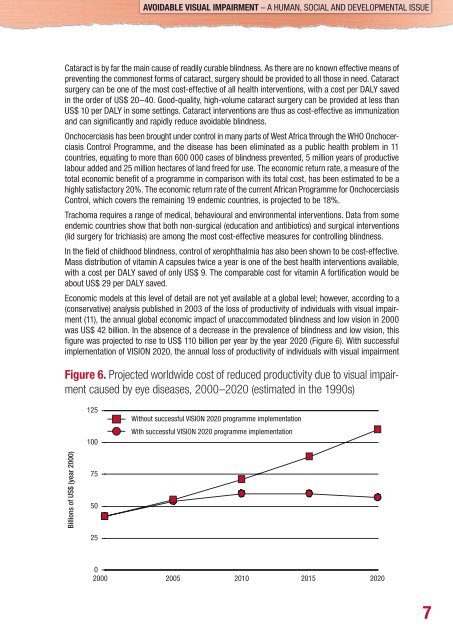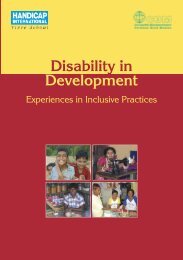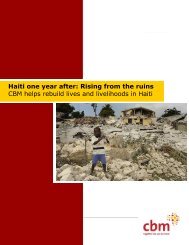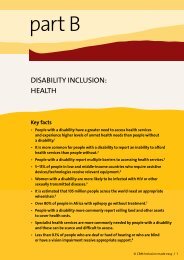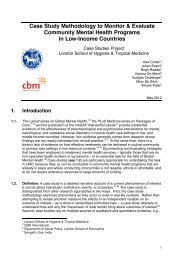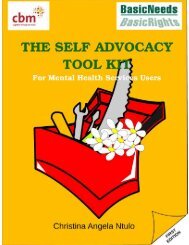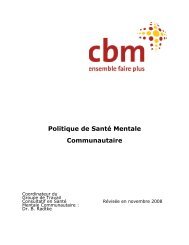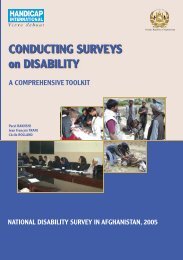Vision 2020 - World Health Organization
Vision 2020 - World Health Organization
Vision 2020 - World Health Organization
You also want an ePaper? Increase the reach of your titles
YUMPU automatically turns print PDFs into web optimized ePapers that Google loves.
AVOIDABLE VISUAL IMPAIRMENT – A HUMAN, SOCIAL AND DEVELOPMENTAL ISSUE<br />
Cataract is by far the main cause of readily curable blindness. As there are no known effective means of<br />
preventing the commonest forms of cataract, surgery should be provided to all those in need. Cataract<br />
surgery can be one of the most cost-effective of all health interventions, with a cost per DALY saved<br />
in the order of US$ 20–40. Good-quality, high-volume cataract surgery can be provided at less than<br />
US$ 10 per DALY in some settings. Cataract interventions are thus as cost-effective as immunization<br />
and can signifi cantly and rapidly reduce avoidable blindness.<br />
Onchocerciasis has been brought under control in many parts of West Africa through the WHO Onchocerciasis<br />
Control Programme, and the disease has been eliminated as a public health problem in 11<br />
countries, equating to more than 600 000 cases of blindness prevented, 5 million years of productive<br />
labour added and 25 million hectares of land freed for use. The economic return rate, a measure of the<br />
total economic benefi t of a programme in comparison with its total cost, has been estimated to be a<br />
highly satisfactory 20%. The economic return rate of the current African Programme for Onchocerciasis<br />
Control, which covers the remaining 19 endemic countries, is projected to be 18%.<br />
Trachoma requires a range of medical, behavioural and environmental interventions. Data from some<br />
endemic countries show that both non-surgical (education and antibiotics) and surgical interventions<br />
(lid surgery for trichiasis) are among the most cost-effective measures for controlling blindness.<br />
In the fi eld of childhood blindness, control of xerophthalmia has also been shown to be cost-effective.<br />
Mass distribution of vitamin A capsules twice a year is one of the best health interventions available,<br />
with a cost per DALY saved of only US$ 9. The comparable cost for vitamin A fortifi cation would be<br />
about US$ 29 per DALY saved.<br />
Economic models at this level of detail are not yet available at a global level; however, according to a<br />
(conservative) analysis published in 2003 of the loss of productivity of individuals with visual impairment<br />
(11), the annual global economic impact of unaccommodated blindness and low vision in 2000<br />
was US$ 42 billion. In the absence of a decrease in the prevalence of blindness and low vision, this<br />
fi gure was projected to rise to US$ 110 billion per year by the year <strong>2020</strong> (Figure 6). With successful<br />
implementation of VISION <strong>2020</strong>, the annual loss of productivity of individuals with visual impairment<br />
Figure 6. Projected worldwide cost of reduced productivity due to visual impairment<br />
caused by eye diseases, 2000–<strong>2020</strong> (estimated in the 1990s)<br />
125<br />
100<br />
Without successful VISION <strong>2020</strong> programme implementation<br />
With successful VISION <strong>2020</strong> programme implementation<br />
Billions of US$ (year 2000)<br />
75<br />
50<br />
25<br />
0<br />
2000 2005 2010 2015 <strong>2020</strong><br />
7


